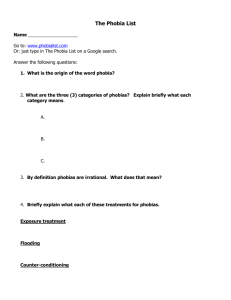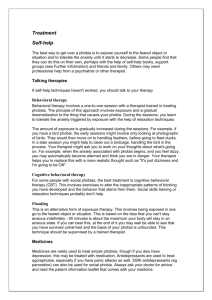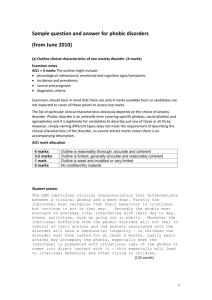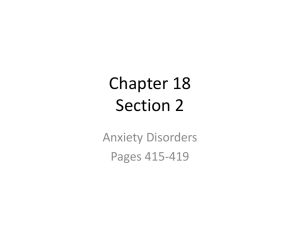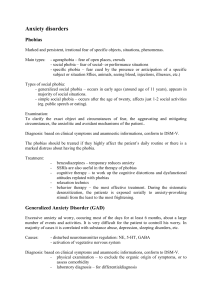Phobias
advertisement
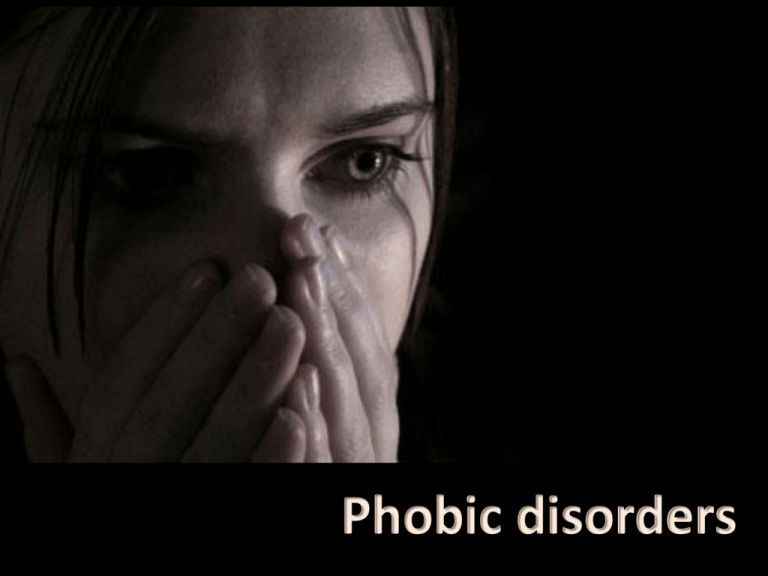
Phobic disorders • Clinical characteristics of the phobic disorders. • Issues surrounding the classification and diagnosis of phobic disorders, including reliability and validity. Explanations • Biological explanations of phobic disorders, for example, genetics, biochemistry. • Psychological explanations of phobic disorders, for example, behavioural, cognitive, psychodynamic and socio-cultural. Overview Therapy • Biological therapies for phobic disorders, including their evaluation in terms of appropriateness and effectiveness. • Psychological therapies for phobic disorders, for example, behavioural, psychodynamic and cognitive-behavioural, including their evaluation in terms of appropriateness and effectiveness. DSM-IV-TR CRITERIA for specific phobia Reduce • Marked and persistent fear that is excessive or unreasonable. • Exposure to the phobic stimulus almost invariably provokes an immediate anxiety response such as a panic attack. • The person recognises that the fear is excessive or unreasonable. This feature may be absent in children. • The phobic situation is avoided or endured with intense anxiety or distress. • The avoidance, anxious anticipation, or distress in the feared situation interferes significantly with the person’s normal routine, • In individuals under age 18 years the duration is at least six months. • The anxiety, panic attacks or phobic avoidance is not better accounted for by another mental disorder, such as OCD Types of specific phobia • Animal type (e.g. spiders, dogs). • Natural environment type (e.g. heights, storms, water). • Blood/injection/injurytype. • Situational type (e.g.aeroplanes, lifts, enclosed places). • Other types (e.g. fear of choking or contracting an illness, or, in children, fear of loud noises or costumed characters). With panic disorder 2. Issues surrounding classification and diagnosis • Mental disorder classified using DSM or ICD. • Diagnosis depends on use of a classification system. • DSM lists 372 disorders. • Diagnosis based on 1. Principal disorder 2. Personality disorder 3. Medical problems 4. Psychosocial stressor 5. Global assessment of functioning 2. Issues surrounding classification and diagnosis = consistency Consistency of a measuring instrument such as a scale to assess fear ratings. Reliability can be measured Inter-rater reliability: whether two independent assessors give similar scores. Test-retest reliability: whether the test is likely to produce the same results on two separate occasions. 2. Issues surrounding classification and diagnosis Inter-rater reliability • Skyre et al. (1991) – three clinicians assess 54 social phobics using the Structured Clinical Interview (SCID-I). High agreement (+.72). SCID requires extensive training which may explain the high reliability. Test-retest • Hiller et al. (1990) to excellent diagnostic agreement using the Munich Diagnostic Checklist (MDC). There is some evidence of poor reliability … Kendler et al. (1999) erviewed phobics (face-toface or over the telephone). Over a one-month interval (test-retest) there was a mean agreement of +.46. Reliability over 8 years was even lower (+.30). This may be explained … Low reliability might be due to the poor recall by participants of their fears (overexaggerating or underexaggerating fears) (Kendler et al.) Interviewers differ in their interpretation of symptoms, concluding it is clinically significant or not affecting whether a diagnosis is made. 2. Issues surrounding classification and diagnosis • = measures what it claims to measure. • = is real i.e. a characteristic of the individual rather than the situation. • A diagnosis cannot be valid if it is not reliable. • Why diagnose if there is no effective treatment specific to phobic disorders? 2. Issues surrounding classification and diagnosis Comorbidity • If two (or more) conditions cooccur this suggests that they are not separate entities and therefore the diagnostic category is not very useful, e.g. when deciding what treatment to advise. • Research has found high levels of comorbidity between social phobias, This is supported by … animal phobias, generalised anxiety Up to 66% of patients with one anxiety disorder are also diagnosed with another anxiety disorder (Eysenck, 1997). disorder and The implications are that the diagnosis should simply be depression (e.g. Kendler et al., 1993). ‘anxiety disorder’ rather than phobia or obsessive compulsive disorder (OCD). 2. Issues surrounding classification and diagnosis Concurrent validity • A means of establishing validity by comparing an existing a test/questionnaire with the one you are interested in. • Mattick and (1998) that their Social Phobia Scale (SPS) correlated well with other standard measures (varying between +.54 and +.69). Construct validity • A means of assessing the validity or trueness of a psychological test by demonstrating the extent to which performance on the test measures an identified underlying construct. • Beidel et al. (1989) found the Social Phobia and Anxiety Inventory (SPAI) correlates well with behavioural measures of social phobia (e.g. ease of public speaking) and lacks association with behaviours unrelated to social phobia. 2. Issues surrounding classification and diagnosis Validity may be increased using computer diagnosis … Computerised scales for assessing phobic disorders may be preferable because the presence of another person can create fears of negative evaluation. Computerised scales also mean there is less of an effect of interviewer expectations on the patient’s answers (Kobak et al., 1993). Gender bias … Women are more likely to be diagnosed with specific phobias, possibly because clinicians are influenced by gender stereotypes (Worrell and Remer). Culture differences … Taijin-kyofusho (TKS) is a culturally distinctive phobia recognised in Japan. This is a social phobia where an individual has a fear of embarrassing others in social situations. In the UK a person exhibiting such symptoms would not be diagnosed with a social phobia, indicating the effect of cultural experiences on the diagnosis of a disorder. 2. Issues surrounding classification and diagnosis • Rosenhan (1973) Sane in Insane Places • Pseudopatients diagnosed with schizophrenia despite being normal except for saying they heard voices. • Showed that diagnosis lacked validity, based on situational factors rather than a characteristic of the person. • Follow up study – real patients underdiagnosed because clinicians leaning towards a Type 2 error (avoiding a false positive – calling a healthy person sick). End up calling a sick person healthy (Type 2, false negative). Later research has not supported this Spitzer et al. (1975) gave 74 emergency room psychiatrists a detailed case description and found that only three offered a diagnosis of psychotic depression and only one third recommended medication. Part 2 Explanations Biological Psychological Biological: Genetic Family studies • Fyer et al. (1995): probands had 3x as many relatives with phobias compared to normal controls. • Usually the same disorder as the proband, e.g. Ost (1989)found that 64% of blood phobics had a least one relative with the same disorder. Twin studies • Torgersen (1983) compared MZ and same-sex DZ twin pairs with anxiety disorders with panic attacks. 5X more frequent in MZ twin pairs. Biological: Genetic Family studies • Fyer et al. (1995): probands had 3x as many relatives with phobias compared to normal controls. • Usually the same disorder as the proband, e.g. Ost (1989)found that 64% of blood phobics had a least one relative with the same disorder. Twin studies • Torgersen (1983) compared MZ and same-sex DZ twin pairs with anxiety disorders with panic attacks. 5X more frequent in MZ twin pairs. Some phobias have a greater genetic component than others … Kendler et al. (1992) estimated a 67% heritability rate for agoraphobia, 59% for blood/injury, 51% for social phobias and 47% for animal phobias. One of the problems with family and twin studies … they fail to control for shared experiences. MZ twins are likely to share more similar experiences (environments) than DZ twins. The diathesis-stress model … It is likely that genetic factors predispose an individual to develop phobias but experience plays a role in triggering such responses. Biological: Genetic Inherited tendencies • High levels of arousal in the ANS, which creates increased amounts of adrenaline and this leads to an oversensitive fear response (adrenogenic theory). • Dopamine pathways in the brain may predispose some people to be more readily conditioned so that they are more likely to acquire phobias easily. Biological: Genetic Inherited tendencies • High levels of arousal in the ANS, which creates increased amounts of adrenaline and this leads to an oversensitive fear response (adrenogenic theory). • Dopamine pathways in the brain may predispose some people to be more readily conditioned so that they are more likely to acquire phobias easily. There is research support … Children with signs of behavioural inhibition at birth (a tendency to withdraw from unfamiliar people and situations) were found to later have higher ANS activity and develop significantly more anxiety disorders (Biederman et al., 1993). Successful drug therapies for phobics include drugs that block activity of the adrenergic system (betablockers), reducing anxiety. Tiihonen et al. found a lower number of dopamine reuptake sites in patients with social phobia, which would lead to low levels of dopamine. However … this does not show that such differences actually cause phobias in the first place, e.g. drugs may be treating symptoms that have arisen as an effect rather than the cause of phobias. Biological: Evolutionary Modern phobias are often related to ancient fears (e.g. snakes, heights) rather than modern dangers (e.g. guns, electricity) because no adaptive selection yet (Marks and Nesse, 1994). Prepotent •Inherited tendency to respond prior to direct experience, e.g. to respond anxiously to snake-like movement or sounds. Prepared •Inherited tendency to rapidly learn an association between a stimuli (i.e. potentially life-threatening) and fear, and once learned this association is difficult to extinguish. Biological: Evolutionary Modern phobias are often related to ancient fears (e.g. snakes, heights) rather than modern dangers (e.g. guns, electricity) because no adaptive selection yet (Marks and Nesse, 1994). Prepotent •Inherited tendency to respond prior to direct experience, e.g. to respond anxiously to snake-like movement or sounds. Prepared •Inherited tendency to rapidly learn an association between a stimuli (i.e. potentially life-threatening) and fear, and once learned this association is difficult to extinguish. May not explain clinical phobias. Öhman and Soares (1994) people who were fearful of snakes or spiders showed a greater fear response (SNS activity measured by GSR) when shown masked (not immediately recognisable) pictures of snake/spiders. This shows that people respond to prepotent signals. McNally (1987) reviewed lab studies (participants conditioned to fear prepared and unprepared stimuli). The participants showed resistance to extinction of fear responses conditioned by ‘prepared’ stimuli, but evidence for rapid acquisition was, at best, equivocal. Exam Corner Outline and evaluate one psychological explanation for either phobic disorders or obsessive compulsive disorder. (4 marks + 6 marks) Jan 2011 Outline one psychological explanation and one biological explanation for either phobic disorders or obsessive compulsive disorder. (9 marks) Evaluate explanations for either phobic disorders or obsessive compulsive disorder. (16 mark) Outline at least one biological explanation of depression and at least one psychological explanation of depression. (9 marks) Evaluate biological and psychological explanations of depression. (16 marks) The plurality rule Discuss one biological explanation of gender. Discuss two biological explanations of gender. • You use your ‘best’ explanation. • IF you only discuss one explanation, you can get up to ⅔ of the total marks i.e. 16 marks (which is a Grade A). • For explanation number 2 you only need a ‘small’ version. Psychological: Psychodynamic Little Hans (Freud, 1909) Hans, aged 4, became terrified of horses. Freud suggested that Hans’ phobia developed because Hans projected a real fear (that his mother would leave him) onto horses (because he heard a man say ‘Don’t put your finger to the white horse or it’ll bite you’ and Hans also once asked his mother if she would like to put her finger on his penis). Psychological: Psychodynamic Little Hans (Freud, 1909) Hans, aged 4, became terrified of horses. Freud suggested that Hans’ phobia developed because Hans projected a real fear (that his mother would leave him) onto horses (because he heard a man say ‘Don’t put your finger to the white horse or it’ll bite you’ and Hans also once asked his mother if she would like to put her finger on his penis). • A case study concerns one unique individual. • Hans’ phobia could be explained in terms of classical conditioning (Hans associated horses with fear). However there is other research support … • Bowlby (1973) agoraphobics often had early experiences of family conflict. Conflict leads a young child to feel very anxious when separated from their parents (separation anxiety). Such fears are suppressed but later emerge as agoraphobia. • Whiting et al. (1966) found that phobias were more common in societies that had a structured form of childrearing – stricter, structured parenting might lead to children having to repress desires. • The fact that therapies that simply target the symptoms of phobia (e.g. SD) are not 100% successful may be because they fail to deal with the underlying causes. Psychological: Behavioural Classical conditioning Little Albert (Watson and Raynor, 1920) • UCS (loud noise) UCR (fear) • NS (furry object) associated with UCS. • The furry object (now a CS) CR (fear). Operant conditioning Two-process theory (Mowrer, 1947), phobias acquired: 1. Through classical conditioning. 2. Maintained through operant conditioning, the avoidance of the phobic stimulus reduces fear and is thus reinforcing (negative reinforcement). Social learning • Imitation, e.g. seeing a parent afraid of spider. Psychological: Behavioural Classical conditioning Not everyone who is bitten by a dog develops a phobia gs (Di Nardo et al., 1988). Perhaps only those with a genetic vulnerability for phobias are affected (diathesis-stress model). Operant conditioning Biological preparedness … Bregman (1934) failed to condition a fear response in infants by pairing a loud bell with wooden blocks. Neutral stimulus may need to be an ‘ancient fear’ (e.g. an animal). Social learning Bandura and Rosenthal (1966) an observer watched a model apparently experiencing pain every time a buzzer sounded. The observer later demonstrated an emotional reaction to the sound. Cultural differences … explained e.g. each society offers its own culture-specific models that influence which phobias might be acquired. We can conclude … Different phobias may be the result of different processes, e.g. Sue et al. (1994) found that agoraphobics were most likely to explain their disorder in terms of a specific incident whereas arachnophobics were most likely to cite modelling as the cause. Part 3 Therapies Biological Psychological Biological: Chemotherapy Antianxiety drugs: Benzodiazepines • BZs slow down the activity of the central nervous system by enhancing the activity of GABA. • Locks onto GABA receptors on receiving neurons, opens a channel to increase the flow of chloride ions into the neuron. Chloride ions make it harder for the neuron to be stimulated by other neurotransmitters. Biological: Chemotherapy Antianxiety drugs: Benzodiazepines • BZs slow down the activity of the central nervous system by enhancing the activity of GABA. • Locks onto GABA receptors on receiving neurons, opens a channel to increase the flow of chloride ions into the neuron. Chloride ions make it harder for the neuron to be stimulated by other neurotransmitters. Effectiveness? Kahn et al. (1986) found that BZs were more effective than placebos in reducing anxiety. However … benefits may be largely explained in terms of placebo effects. Appropriateness? Side effects … BZs may cause increased aggressiveness and long-term impairment of memory – though recent research (Kindt et al. 2009) has proposed that such negative effects might be used to remove anxiety-causing memories. Addiction … BZs may become addictive, even when only low doses are given. A maximum use of four weeks is recommended (Ashton, 1997). Biological: Chemotherapy Antianxiety drugs: Beta-blockers reduce the activity of adrenaline (SNS response to stress). Biological: Chemotherapy Antianxiety drugs: Beta-blockers reduce the activity of adrenaline (SNS response to stress). Effectiveness? Research studies (e.g. Liebowitz et al., 1985) have shown that BBs can also provide an effective means of anxiety control. However … Turner et al. found no difference between BB and placebo groups in terms of reduced heart rate, feelings of nervousness and so on. Appropriateness? BBs have few side effects and no addiction. Biological: Chemotherapy Antidepressants • SSRIs, are currently the preferred drug for treating anxiety disorders (Choy and Schneier, 2008). They increase levels of the neurotransmitter serotonin that regulates mood/anxiety. • MAOI, older class of antidepressants, are more effective with some patients (Lader and Petursson, 1983). Monoamine oxidase (MAO) is the enzyme responsible for breaking down monoamine neurotransmitters (e.g. serotonin and dopamine) so an inhibitor prevents this happening, leading to higher levels of monoamines in the synaptic gap. Biological: Chemotherapy Antidepressants • SSRIs, are currently the preferred drug for treating anxiety disorders (Choy and Schneier, 2008). They increase levels of the neurotransmitter serotonin that regulates mood/anxiety. • MAOI, an older class antidepressants, are more effective with some patients (Lader and Petursson, 1983). Monoamine oxidase (MAO) is the enzyme responsible for breaking down monoamine neurotransmitters (e.g. serotonin and dopamine) so an inhibitor prevents this happening, leading to higher levels of monoamines in the synaptic gap. Effectiveness? SSRIs led to improved levels of selfrated anxiety when compared to a placebo treatment (Katzelnick et al., 1995). MAOIs have been found to be more effective than placebos and more effective in the reduction of anxiety than BBs (Liebowitz et al., 1992). Appropriateness? SSRIs are linked to increased suicides in adolescents (Barbui et al., 2008). MAOIs have a number of side effects, e.g. dizziness, insomnia. Biological: Chemotherapy Not a cure … Drugs can’t provide a complete treatment as they focus on symptoms (symptom substitution). Ethical issues … The issue of informed consent concerns the extent to which patients are not informed about the fact that drugs may not actually be much better than placebos. Psychological: SD Phobias are perpetuated because the anxiety created blocks any attempt to re-experience the stimulus. Joseph Wolpe (1958) developed a technique where the feared stimulus is re-introduced gradually. •Counterconditioning: Forming a new association that runs counter to the original association. ‘Reciprocal inhibition’ because the relaxation inhibits the anxiety. •Desensitisation hierarchy: Therapist and patient construct a series of imagined scenes, each one progressively more fearful. They then work through this hierarchy, relaxing and mastering each stage before moving on to the next. •Different forms of SD: In vivo, covert (also known as in vitro), flooding. Psychological: SD Effectiveness ? • Research has found that SD is successful for a range of phobic disorders, e.g. McGrath et al. (1990) found about 75% success rates. • In vivo techniques more successful than covert ones (Menzies and Clarke, 1993), though often a number of different exposure techniques are involved – in vivo, covert and modelling where the patient watches someone else who is coping well with the feared stimulus (Comer). • However … Öhman et al. (1975) suggest that SD may not be as effective in treating phobias that have an underlying evolutionary survival component (e.g. fear of the dark or dangerous animals). Appropriateness ? • SD requires less effort from the patient than other psychotherapies. • SD can be self-administered, a method that has proved successful with, for example, social phobia. • Positive expectancies may be the most important ingredient, e.g. Klein et al. (1983) found SD and supportive psychotherapy equally effective for patients with either social or specific phobias. Psychological: REBT Ellis proposed that phobias occur because of irrational thinking. ABC model (Ellis, 1957) A = activating event e.g. friend ignores you in the street. B = irrational beliefs arising from A, e.g. your friend must have decided he doesn’t like you; no one likes you, you are worthless. C = self-defeating consequences, e.g. avoid social situations in the future. Disputing •Logical disputing e.g. ‘Does thinking this way make sense?’. •Empirical disputing (evidence based) e.g. ‘Where is the proof that this belief is accurate?’. Psychological: REBT Effectiveness ? • REBT has generally done well in outcome studies, e.g. a meta-analysis by Engels et al. (1993). • Ellis (1957) claimed a 90% success rate, taking an average of 27 sessions to complete. • However … Emmelkamp et al. (1998) concluded that REBT was less effective than in vivo exposure treatments, at least for agoraphobia. Appropriateness ? • Not suitable for all … Ellis believed that some people don’t put their revised beliefs into action or don’t want the direct sort of advice and cognitive effort associated with REBT. • There is research support … People who hold irrational beliefs form inferences that are significantly less functional than those that are formed by people who hold rational beliefs (Bond and Dryden, 2002). • Ethical issues … REBT is regarded as one of the most aggressive CBTs (Rosenhan and Seligman, 1989) and, in addition, it is judgmental. These aspects of the therapy raise ethical concerns because of the psychological harm that may be caused to a person’s self-esteem. Exam Corner Briefly describe one psychological therapy for the anxiety disorder that you outlined in your answer to. (5 marks) Evaluate psychological therapies for this anxiety disorder. (16 marks) June 2010 Reduce Essay answer to mark (a) Outline clinical characteristics of one anxiety disorder. (4 marks) Examiner notes AO1 = 4 marks The outline might include: • physiological, behavioural, emotional and cognitive signs/symptoms • incidence and prevalence • course and prognosis • diagnostic criteria Examiners should bear in mind that there are only 4 marks available here so candidates are not expected to cover all these points to access top marks. The list of particular clinical characteristics obviously depends on the choice of anxiety disorder. Phobic disorder is an umbrella term covering specific phobias, social phobias and agoraphobia and it is legitimate for candidates to describe just one of these or all three. However, simply naming different types does not meet the requirement of describing the clinical characteristics of the disorder, so cannot attract marks unless there is an accompanying description. Essay answer to mark (a) Outline clinical characteristics of one anxiety disorder. (4 marks) The DSM identifies clinical characteristics that differentiate between a clinical phobia and a mere fear. Firstly the individual must recognise that their behaviour is irrational but continue to act in that way. Secondly the phobia must encroach on everyday life, interfering with their day to day, normal activities, such as going out in public. Moreover the individual suffering from the phobic disorder will not feel in control of their actions and the anxiety associated with the disorder will have a substantial longevity – in children the disorder must have lasted for at least 6 months. Lastly panic attacks may accompany the phobia, especially when the individual is presented with situational cues of the phobia or comes into direct contact with it – this especially will lead to irrational behaviour and often crying in children. (132 words) Essay answer to mark (b) Briefly describe one psychological therapy for the anxiety disorder that you outlined in your answer to part (a). (5 marks) Examiner notes AO1 = 5 marks AO1 is a brief outline of one psychological therapy for the chosen anxiety disorder. If candidates outline more than one type of therapy, examiners should look at both accounts and credit the one which attracts most marks. Answers which describe a biological therapy eg drugs attract no credit. The most likely therapy is some form of behavioural therapy eg systematic desensitisation or implosion for phobias, or for OCD, ERP or modelling. AO1 mark allocation Essay answer to mark (b) Briefly describe one psychological therapy for the anxiety disorder that you outlined in your answer to part (a). (5 marks) Systematic desensitisation is a psychological therapy used to help the suffering individual overcome their fear. Joseph Wolpe originally came up with the therapy and suggested that deep relaxation is the key to overcoming the fear as relaxation and anxiety are not able to occur at the same time. Wolpe came up with the idea of counterconditioning – once an individual is able to relax fully, it is possible to replace the conditioned stimuli to which they have attached their phobia with a more positive conditioned stimuli taking their place. For example, research was carried out where cats were conditioned to acquire a phobia of a box in which they were placed. The researchers gave the cats electric shocks so they were conditioned to have a phobic response to the box. Counterconditioning took place when the cats were fed in the box because they no longer associated it with the box. continued …… Essay answer to mark In order to relate this to humans, Wolpe invented the idea of a desensitisation hierarchy, which has many stages and each brings the phobic closer to confronting their fear. They may find it is not so scary after all but prior to systematic desensitisation they were unable to confront it to find out. Wolpe developed ‘in vivo’ type of systematic desensitisation and also a ‘covert’ type. The former actually requires the phobic to physically confront their fear while the covert type just asks participants to imagine pictures of it. ‘Flooding’ is also associated with systematic desensitisation – individuals are shown their phobia prior to any therapy. (254 words) Essay answer to mark (c) Evaluate psychological therapies for this anxiety disorder. (16 marks) Examiner notes AO2/3 = 16 marks Candidates are required to evaluate psychological therapies appropriate for the anxiety disorder outlined in 04. Because evaluation can be very generic, partial performance criteria do not apply. They are likely to consider issues such as appropriateness and effectiveness of the therapies. They can also consider the quality of the research evidence which supports the therapies. Essay answer to mark AO2/AO3 mark scheme Essay answer to mark Subsequent research on systematic desensitisation has confirmed that it is an effective therapy in helping individuals overcome their fears. A significant number of participants responded well to the treatment but it was found that ‘in vivo’ was more effective than the ‘covert’ method. Also systematic desensitisation may, according to research, be more effective on specific phobias rather than social phobias. This may be due to the fact that many specific phobias are exaggerations of ‘ancient fears’ such as snakes and spiders. These phobias are less likely to encroach on the lives of individuals suffering as they are more easily avoidable, whereas social phobias often effect every aspect of a sufferer’s life. A further criticism of systematic desensitization is that it does not treat the cause of an individual’s phobia but only desensitises them to the symptoms they experience when confronted. If, as Freud suggests, their phobia is a result of early trauma and ego conflict, the individual may subsequently relay their true fear onto another object or situation and the cycle will start again. continued … Essay answer to mark However, a strength of the theory is that it can be self-administered and requires little input from participants, so they can go at their own pace. The research mentioned earlier concerning the cats (they were placed in a box and electrocuted to condition a fear response) may have influenced Joseph Wolpe to come up with systematic desensitization, but it has been criticised for being overly reductionist as it is reducing the complexities of overcoming a phobia to a more simple organism, which raises issues as it is not generalisable to the population. Albert Ellis came up with a different psychological therapy for phobias. He proposed that Rational Emotive Behaviour Therapy (REBT) could cure an individual of an addiction by altering the way in which they think. Phobics have been found to have delusional thoughts about themselves and things around themselves and things around them , which may lead them developing a phobia. Ellis targets these irrational thoughts in his therapy, proposing the ABC model as a way of aiding participants to alter their thinking. This has been found to be effective , especially among social phobics as these are thought to be derived from irrational thoughts in many cases. For example, an continued … Essay answer to mark individual may see a friend in the street who ignores them (Activating event). They will then display irrational Belief which will lead to a social phobia of going out in the street as a Consequence. (The irrational belief includes irrational thoughts that the person must hate them). This therapy is effective as it targets the causes of an individual’s phobia but it has been criticised as individual differences play a part in its administration. Many people do not respond to REBT as they do not like to be told what to do and cannot be helped under strict conditions. Others flourish under these conditions and their phobias are ‘cured’. REBT also takes a long time to carry out and has been criticised for being too logical – it is not always as straightforward as that as the phobia has been acquired as a result of one particular, irrational thought. Therefore, REBT is also deterministic as there must be other factors involved or the success rate would be 100%. Also REBT cannot help phobics who do not suffer from irrational thinking. (560 words) EVERY MARK COUNTS June 2010 Unit 3 Average mark = Unit 4 A* A B C D E 54/75 47 40 34 28 22 72% 63% 45% 29% 18 15.7 11.3 7.3 56/85 50 66% 59% 44 38 45% 32 26 31%
